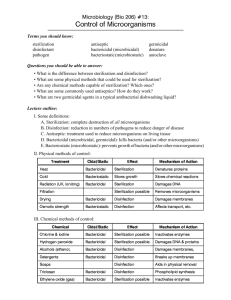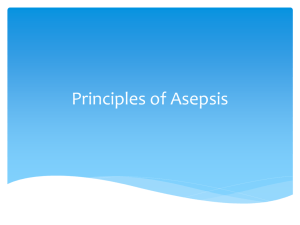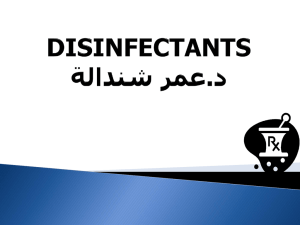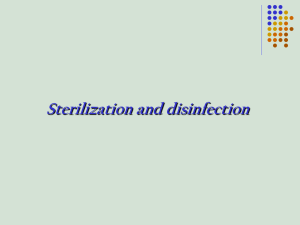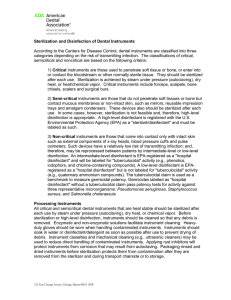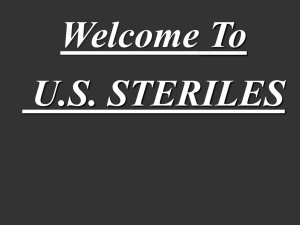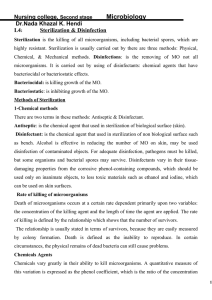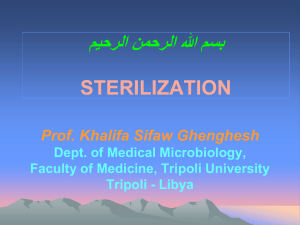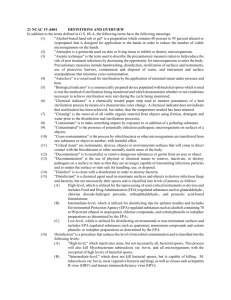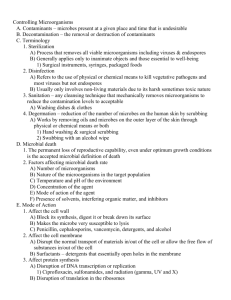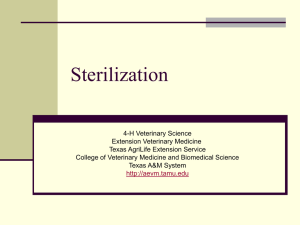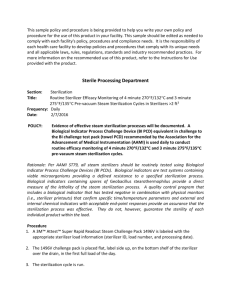Clean_1_11-2011
advertisement
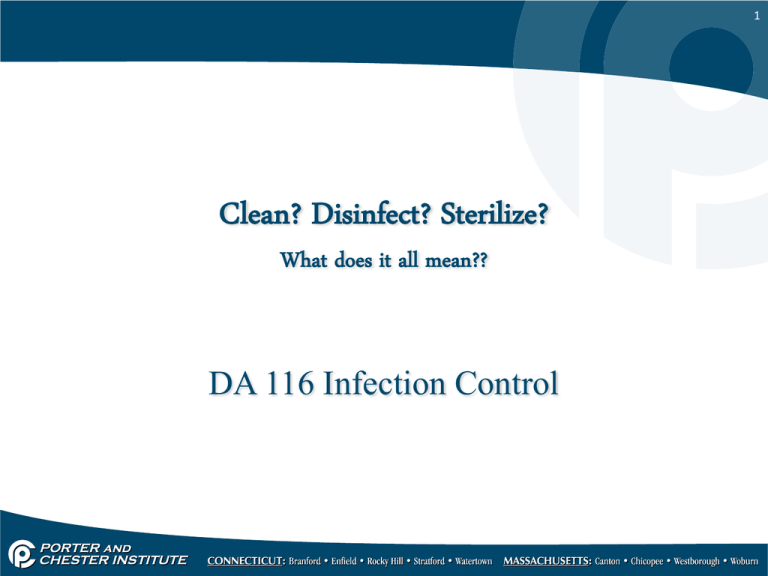
1 Clean? Disinfect? Sterilize? What does it all mean?? DA 116 Infection Control 2 Instruments, supplies, equipment, surfaces After each patient treatment procedure is completed Clean? (“pre-clean”) • Basic first step of decontamination process – Reduce the number of microbes and remove bioburden – Prevent debris from harboring microorganisms during sterilization process **if a surface is not CLEAN it cannot be disinfected** • Remove all disposables and contaminated items from operatory first • Use soap and water OR an EPA-registered product that cleans and disinfects 3 4 Pre-Cleaning the operatory • PPE with utility gloves 5 Pre-Cleaning Instruments preferred method: mechanical cleaning Ultrasonic Cleaner Instrument Washer Disinfect? • After precleaning • NOT the same as sterilization • Kills most disease-causing microorganisms, but not spores – Non-pathogenic microorganisms may remain on an object after disinfection • Use an EPA-registered hospital disinfectant with tuberculocidal, HIV, and HBV claims – Note: Hydrogen Peroxide is NOT an acceptable disinfectant 6 7 8 Levels of Disinfection: • Low level disinfection: (actually cleaning) – Least effective. Does not kill spores or Tuberculosis • Intermediate level disinfection: – Kills TB, which is the most difficult to kill as spores – If you use a process that kills TB spores, you will also be able to kill other organisms that are easier to kill (HBV and HIV) • High level disinfection: – Kills some, but not all bacterial spores, including TB as well as other bacteria, fungi and viruses • Almost as effective as true sterilization but not as thorough 9 Disinfectant Comparisons note: rubbing alcohol is NOT an approved disinfectant Disinfectant Level Advantages Disadvantages Required times Glutaraldehyde High disinfect impressions Corrosive Eye irritation 10-90 min. Iodophor Intermediate Fast acting Residual activity discoloration 10 min on surface Skin/mucous irritation No use on plastics 10 min Corrosive, skin irritation, must prepare daily 2-10 min Cleans and disinfects Complex (synthetic) Phenolics Intermediate Chlorines Intermediate Fast acting Residual activity Clean and disinfect economical 10 Disinfecting Sprays How to Use: For surface disinfection – use the 2 step method. • Clean by wiping surfaces thoroughly with disinfectant and paper towels or 4 x 4 gauze to remove all soils. • Disinfect by reapplying disinfectant, keeping surfaces wet for 10 minutes. Wipe off excess solution after contact time is completed. Place barriers. 11 Disinfecting wipes How to Use: For surface disinfection – use the 2 step method. • To clean, remove one or more wipe towelettes and wipe surfaces thoroughly to remove all soils. Discard used wipe towelettes. • Remove one or more additional fresh wipe towelettes. Reapply disinfectant to previously cleaned surfaces for a 10 minute contact time. 12 Additional Disinfecting Concerns: Radiography • Film holders and positioners for digital radiographs should be heat sterilized between patients, UNLESS they are disposable items. • Sensors for digital radiographs cannot be sterilized and should be covered with a new barrier sleeve for each patient. Dental Lab • All items used in the mouth should be cleaned and soaked in a high level disinfectant before sending to the laboratory for processing. Sterilize? – Process by which all forms of life are completely destroyed • destroys all living microorganisms, including bacterial spores and viruses. Kills good and bad microorganisms, all life – After proper sterilization, no microorganisms will be alive – Heat or Liquid Chemical 13 14 Steam under pressure Steam (autoclave) Flash (Statim) 15 Rapid Heat Sterilization • AKA ‘Statim’ • Works like a convection oven, high temperature plus circulating steam • 375 F degrees (190C) 12 minutes for wrapped items • 375 F degrees (190C) 6 minutes for unwrapped items 16 Autoclave: • • • • • • • • Uses moist heat to sterilize Steam under pressure is considered the sterilizing agent 15 pounds of pressure per square inch 250 degrees F (121 degrees C) For 15-20 minutes for wrapped instruments 30 minutes for porous materials Avoid overloading or wrapping instruments too tightly Steam must circulate to all surfaces 17 Chemical Vapor Sterilizer 18 Chemical Vapor Sterilization: • Combination of heat and unsaturated chemical vapor (produces hot vapors of alcohol and formaldehyde that act as sterilizing agent) • Chemicals used: alcohol, acetone, ketone, formaldehyde and distilled water • Advantage: – No corrosion or dulling of instruments – Instruments are dry at end of cycle – All instruments which can be autoclaved, can be chemiclaved • Disadvantage: needs well ventilated area due to odor • 270 F degrees (131C) 20-40 minutes 20 PSI pressure • Clean, rinse and dry instruments well before sterilizing; wrap loosely 19 Dry Heat Sterilizer 20 Dry Heat Sterilization: • “Baking” – high temperature is sterilizing agent • • • • 320 F degrees (160C degrees) = 2 hours (120 minutes) 340 F degrees (170C degrees) = 1 hour (60 minutes) Advantage: no rust or corrosion or dulling sharp edges Disadvantage: some plastics, gauze, impression trays cannot tolerate high temperatures, can cause damage • Instruments must be clean and dry prior to sterilization • Usually requires special metal instrument trays used during sterilization 21 Glass Bead Sterilizer Ethylene Oxide Sterilizer 22 Glass Bead Sterilizer: • *no longer OSHA accepted • Previously used chairside during endodontic procedures to sterilize files between canals – used on the same patient • Consists of glass beads, metal beads and salt • 450 degrees F, for 20-30 seconds • The set of files are then autoclaved between patients 23 Ethylene Oxide Sterilizer • This is another chemical sterilization method • Considered a poisonous gas • Runs on a 10-16 hour cycle • Used in hospitals but not in dental settings Liquid Sterilant (cold sterilant or high-level disinfectant) • Glutaradehyde product 24 25 Liquid Sterilants: • • • AKA “Cold Sterilants” Destroys all microorganisms IF exposed long enough to the sterilant Disadvantage: – Time consuming (10 – 16 hours) – No bacterial spore test available; May use a color monitor dip stick to test the strength – Whenever new item is added, time is reset to ten hours – Toxic chemicals: glutaraldehyde; • do not leave container uncovered • • • Advantage: – No packaging; will not harm heat sensitive items Clean and dry everything before immersion; any water will dilute solution and lower effectiveness After cycle, must rinse with sterile water; dry with clean towels, and wrap in clean packaging 26 Sterilization Monitoring – Biological monitoring with spore tests: Liquid Disinfectant Monitoring: color monitor dip stick (not a spore test) • Process indicators
